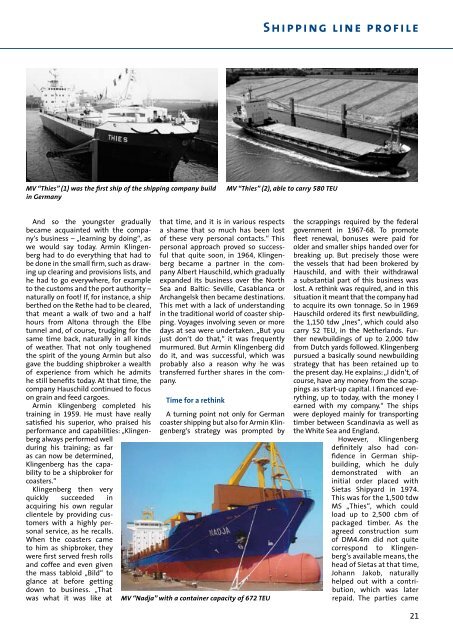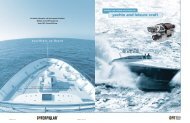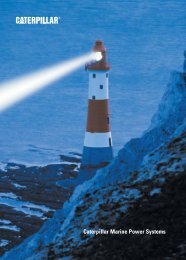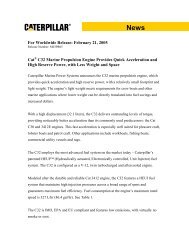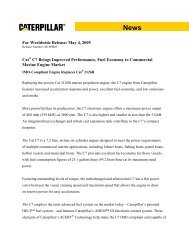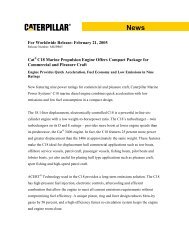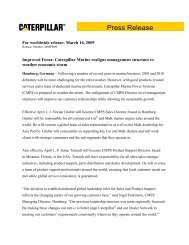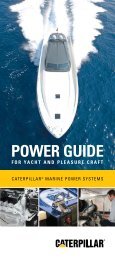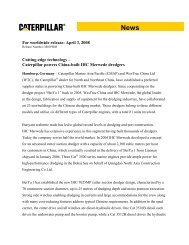Caterpillar Marine - Marine Engines Caterpillar
Caterpillar Marine - Marine Engines Caterpillar
Caterpillar Marine - Marine Engines Caterpillar
You also want an ePaper? Increase the reach of your titles
YUMPU automatically turns print PDFs into web optimized ePapers that Google loves.
MV “Thies” (1) was the first ship of the shipping company build<br />
in Germany<br />
And so the youngster gradually<br />
became acquainted with the company‘s<br />
business – „learning by doing“, as<br />
we would say today. Armin Klingenberg<br />
had to do everything that had to<br />
be done in the small firm, such as drawing<br />
up clearing and provisions lists, and<br />
he had to go everywhere, for example<br />
to the customs and the port authority –<br />
naturally on foot! If, for instance, a ship<br />
berthed on the Rethe had to be cleared,<br />
that meant a walk of two and a half<br />
hours from Altona through the Elbe<br />
tunnel and, of course, trudging for the<br />
same time back, naturally in all kinds<br />
of weather. That not only toughened<br />
the spirit of the young Armin but also<br />
gave the budding shipbroker a wealth<br />
of experience from which he admits<br />
he still benefits today. At that time, the<br />
company Hauschild continued to focus<br />
on grain and feed cargoes.<br />
Armin Klingenberg completed his<br />
training in 1959. He must have really<br />
satisfied his superior, who praised his<br />
performance and capabilities: „Klingenberg<br />
always performed well<br />
during his training; as far<br />
as can now be determined,<br />
Klingenberg has the capability<br />
to be a shipbroker for<br />
coasters.“<br />
Klingenberg then very<br />
quickly succeeded in<br />
acquiring his own regular<br />
clientele by providing customers<br />
with a highly personal<br />
service, as he recalls.<br />
When the coasters came<br />
to him as shipbroker, they<br />
were first served fresh rolls<br />
and coffee and even given<br />
the mass tabloid „Bild“ to<br />
glance at before getting<br />
down to business. „That<br />
was what it was like at<br />
that time, and it is in various respects<br />
a shame that so much has been lost<br />
of these very personal contacts.“ This<br />
personal approach proved so successful<br />
that quite soon, in 1964, Klingenberg<br />
became a partner in the company<br />
Albert Hauschild, which gradually<br />
expanded its business over the North<br />
Sea and Baltic: Seville, Casablanca or<br />
Archangelsk then became destinations.<br />
This met with a lack of understanding<br />
in the traditional world of coaster shipping.<br />
Voyages involving seven or more<br />
days at sea were undertaken. „But you<br />
just don‘t do that,“ it was frequently<br />
murmured. But Armin Klingenberg did<br />
do it, and was successful, which was<br />
probably also a reason why he was<br />
transferred further shares in the company.<br />
Time for a rethink<br />
A turning point not only for German<br />
coaster shipping but also for Armin Klingenberg‘s<br />
strategy was prompted by<br />
MV “Nadja” with a container capacity of 672 TEU<br />
Shipping line profile<br />
MV “Thies” (2), able to carry 580 TEU<br />
the scrappings required by the federal<br />
government in 1967-68. To promote<br />
fleet renewal, bonuses were paid for<br />
older and smaller ships handed over for<br />
breaking up. But precisely those were<br />
the vessels that had been brokered by<br />
Hauschild, and with their withdrawal<br />
a substantial part of this business was<br />
lost. A rethink was required, and in this<br />
situation it meant that the company had<br />
to acquire its own tonnage. So in 1969<br />
Hauschild ordered its first newbuilding,<br />
the 1,150 tdw „Ines“, which could also<br />
carry 52 TEU, in the Netherlands. Further<br />
newbuildings of up to 2,000 tdw<br />
from Dutch yards followed. Klingenberg<br />
pursued a basically sound newbuilding<br />
strategy that has been retained up to<br />
the present day. He explains: „I didn‘t, of<br />
course, have any money from the scrappings<br />
as start-up capital. I financed everything,<br />
up to today, with the money I<br />
earned with my company.“ The ships<br />
were deployed mainly for transporting<br />
timber between Scandinavia as well as<br />
the White Sea and England.<br />
However, Klingenberg<br />
definitely also had confidence<br />
in German shipbuilding,<br />
which he duly<br />
demonstrated with an<br />
initial order placed with<br />
Sietas Shipyard in 1974.<br />
This was for the 1,500 tdw<br />
MS „Thies“, which could<br />
load up to 2,500 cbm of<br />
packaged timber. As the<br />
agreed construction sum<br />
of DM4.4m did not quite<br />
correspond to Klingenberg‘s<br />
available means, the<br />
head of Sietas at that time,<br />
Johann Jakob, naturally<br />
helped out with a contribution,<br />
which was later<br />
repaid. The parties came<br />
21


